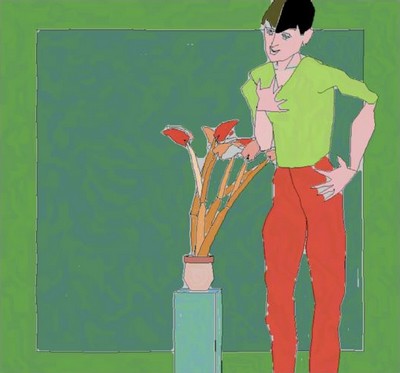Harold Cohen: AARON
Whitney Museum of American Art, New York
Through May 19, 2024
AARON KCAT, 2001
Screenshot. Artificial intelligence software
Dimensions variable
Whitney Museum of American Art, New York
Purchase, with funds from the Digital Art Committee 2023.20
© Harold Cohen Trust
AARON KCAT, 2001
Screenshot. Artificial intelligence software
Dimensions variable
Whitney Museum of American Art, New York
Purchase, with funds from the Digital Art Committee 2023.20
© Harold Cohen Trust
The Whitney Museum of American Art presents the exhibition Harold Cohen: AARON which examines the evolution of AARON, the first AI artmaking program, which was developed in the late 1960s by artist Harold Cohen. Beginning with AARON’s creation and early years, the exhibition explores the foundational stages of AI and its place in art history. In addition to featuring AARON’s drawings and paintings from the Whitney Museum’s collection, the show highlights the software as the central creative force behind the artworks and demonstrate AARON’s drawing process with pen plotters live in the galleries for the first time since the 1990s. The Whitney is the first and only museum to collect versions of the AARON software from different time periods. Providing an important historical perspective on current AI tools, AARON’s functionality is based on knowledge distilled into rules coded by the artist, which differs from today’s AI image creation tools like DALL-E, Midjourney, and Stable Diffusion, which generate their output from existing images on the basis of a user’s text prompts.
“Harold Cohen’s AARON has iconic status in digital art history, but the recent rise of AI artmaking tools has made it even more relevant. Cohen’s software provides us with a different perspective on image making with AI,” says Christiane Paul, Curator of Digital Art at the Whitney. “What makes AARON so remarkable is that Cohen tried to encode the artistic process and sensibility itself, creating an AI with knowledge of the world that tries to represent it in ever-new freehand line drawings and paintings. Watching AARON’s creations drawn live as they were half a century ago will be a unique experience for viewers.”
Harold Cohen considered creativity a result of dialogue between the program and programmer and viewed AARON as his equal collaborator. The artist built his own pen plotters and painting machines to realize AARON’s outputs in various ways throughout its evolution. In AARON’s early years, Harold Cohen manually added color to black-and-white drawings that AARON made with a pen plotter, generating novel images on paper based on its interpretation of Cohen’s coded commands. Modernized re-creations of Harold Cohen’s early drawing machines, constructed specifically for this exhibition, will be installed in the galleries and draw images from different iterations of the AARON software. There will also be large-scale projections of two versions of the AARON program—one creating figurative outputs, the other generating images of flora.
AARON KCAT, 2001
Screenshot. Artificial intelligence software
Dimensions variable
Whitney Museum of American Art, New York
Purchase, with funds from the Digital Art Committee 2023.20
© Harold Cohen Trust
AARON KCAT, 2001
Screenshot. Artificial intelligence software
Dimensions variable
Whitney Museum of American Art, New York
Purchase, with funds from the Digital Art Committee 2023.20
© Harold Cohen Trust
HAROLD COHEN (1928–2016) was a British artist whose innovations at the forefront of technology shaped the field of digital art. Harold Cohen’s artistic practice resulted in his famed creation AARON, the first artificial intelligence software designed to create art independently. After graduating from the Slade School of Fine Art, Harold Cohen had a successful career as a painter, representing the UK at the 1966 Venice Biennale and exhibiting at Documenta III, the Paris Biennale, and the Carnegie International. In 1968, Harold Cohen relocated to the United States as a visiting lecturer at the University of California, San Diego (UCSD), where he remained for almost three decades as a professor, chairman of the Visual Arts Department, and eventually, in 1992, director of the Center for Research in Computing and the Arts. During his time at UCSD, Harold Cohen developed AARON, an evolving artwork to which he would devote the rest of his life, exploring the possibilities of generative artificial intelligence for artmaking. Harold Cohen’s software attracted global attention and was exhibited at major institutions and venues, including the San Francisco Museum of Modern Art, Stedelijk Museum, and Documenta 6. After retiring from UCSD, Harold Cohen continued to work on AARON and produce new artworks in his studio in Encinitas, California. In 2014, Harold Cohen received the ACM SIGGRAPH Distinguished Artist Award for Lifetime Achievement in Digital Art.
Harold Cohen: AARON is organized by Christiane Paul, Curator of Digital Art, with David Lisbon, Curatorial Assistant. The exhibition is organized in collaboration with the Estate of Harold Cohen, which is represented by Gazelli Art House. Modernized re-creations of the plotters were fabricated by Bantam Tools, courtesy Bre Pettis.
WHITNEY MUSEUM OF AMERICAN ART, NEW YORK CITY
HAROLD COHEN: AARON - WHITNEY MUSEUM OF AMERICAN ART
FEBRUARY 3 - MAY 19, 2024





